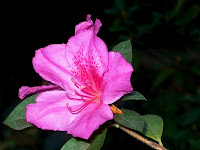
. . . & what I call a Potato creeper - I'm not sure if that is this plant's name!??
Luckily I have no problem identifying this large Sun flower . . .
. . . whilst (colour-wise) these are not very common red Amaryllis . . .
. . . a lily-white Water lily . . .
. . . & last but not least a nice pink Rose - probably the most easily recognised flower in the world??
Wednesday, January 25, 2012
Flower Power
Sunday, January 15, 2012
Thickbilled Weavers



A chick leaves the nest after 19-22 days, but at first is still fed by the female. I snapped a series of photos of this tiny Thickbilled weaver appearing barely able to "hang on" after obviously having just left its nest for the very first time . . .
. . . whilst 2 somewhat older chicks looked on/appeared amazed by the tiny one's "antics". Whilst this happened in a relatively silent manner . . .
. . . other chicks - precariously balancing on the bulrush - chirped loudly from hunger & to catch their mother's attention.
Occassionally a female Thickbilled weaver - similar in appearance to the youngsters - "made an appearance" . . .
. . . which seemed to appease the chicks, even if they weren't fed. After all the "excitement" the youngsters appeared to tire easily, so the chirping stopped for a while - only to resume the moment they sensed a female's pressence.
With a magnificent specimen (= male) on display, the following came to mind ("pronounced" by 1 of the chicks): When I grow up . . .
Thursday, January 5, 2012
Camouflage or Illusion

On the other hand these 2 Black-bellied korhaan are blending in with the environment & therefore are well-camouflaged.
Is this lioness well-camouflaged, i.e. blending in with the environment - or is it more a matter of colour-coordination?
A cheetah - simply well-hidden by long grass or well-camouflaged?
In the case of this small antelope - a duiker - colour functions as concealment = to deceive an enemy.
In contrast to all of the above, this is more a matter of illusion instead of concealment/ camouflage to escape detection - doesn't it appear as if the giraffe (on the right) is bending closer/kissing/licking the group of vultures "parked" at this watering hole?
To end this as it started = another look at a group of zebras "bunching" together/"displaying" a lot of stripes ☺















